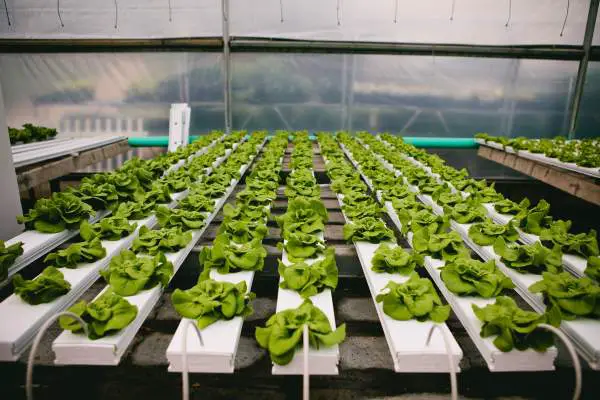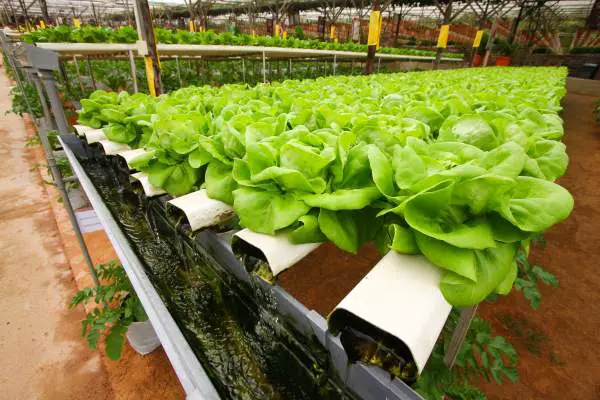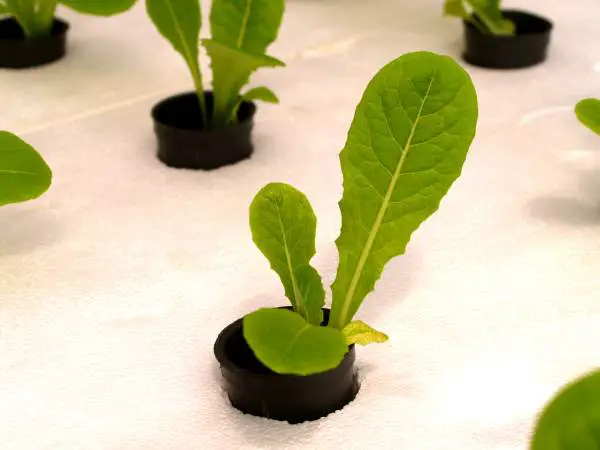With the number of different hydroponic systems available for growers to purchase or build, there isn’t one that looks more elaborate or impressive as an NFT (Nutrient Film Technique) system. While it seems complicated to set up, in practice it is straightforward, and it is very flexible and modular so it can be scaled up without much extra effort.
While being easy to build and maintain, there are still factors that will determine the success or failure of the system.
Here we will cover all you need to know and how to go about building this kind of system, plus any quirks there are once you’re up and running.
How an NFT System Works
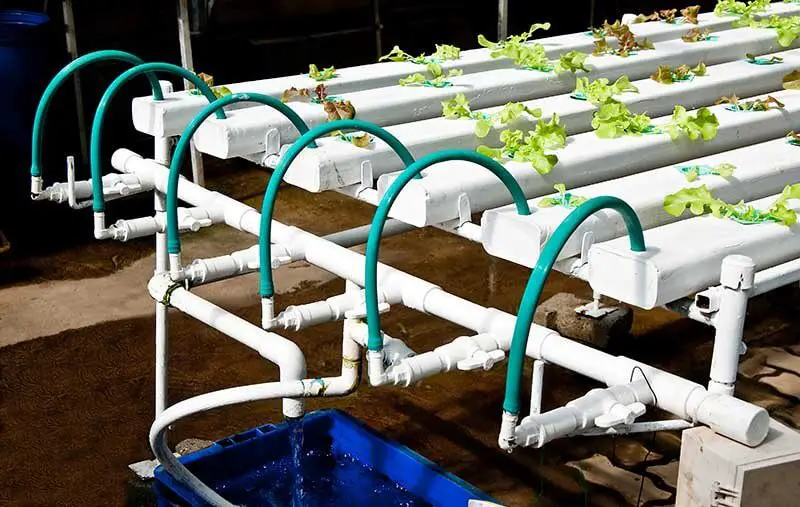
Simply put, you’ll have your channels where the nutrients will run down in a thin film along the bottom of the channel. These channels will be on a slight incline, so gravity pulls the nutrients along, and the water pump’s only purpose is to pump the solution to the highest point. From here, it flows naturally to return back to the reservoir with no further assistance.
When plants have their roots bathing in this film, they are still exposed to the air, so oxygen intake is maximized, while they can absorb as much or as little of the nutrients and water as they require.
For this system, it is effortless to grow leafy green plants that have relatively short growth times. Various types of lettuce, spinach, and broccoli are ideal, as are some herb varieties. For larger plant types, these systems are not suitable because of their weight, and also the mass of roots they will produce.
NFT Trays, Gutters or Tubes
Before going too far, it is worth noting that many growers use PVC tubes for this kind of system. While these still work and appear to be the best, they are in fact not the best means of creating a channel.
The more ideal thing to use is gutters or trays which have a flat bottom. The reason for this being the more substantial surface will create a larger area over which the plant’s roots can spread over. This allows them to feed on a much larger area, and hence, better growth.
Growers who use tubes or channels that come with ribbed bottoms are using materials that aren’t ideal. These create pooling, so the surface area is reduced as is the air-to-nutrient film ratio. While plants will still grow, and grow very well, they may have reduced yields or take longer to mature.
Pros and Cons of an NFT System
It doesn’t matter which type of hydroponic system a grower uses, there will be pros and cons of each. NFT is no different, and there are things to consider. Luckily, the pros can outweigh the cons, so this is a good thing.
NFT Pros
- Low water and nutrient usage
- More economical use of growing media
- Highly modular and can scale easily
- Minimal groundwater contamination due to recirculation
- Easy setup and to maintain
- Easy access to check root condition
- A consistent water flow helps prevent salt buildup
NFT Cons
- A dead pump can cause plants to die quickly
- Not suitable for plants with larger tap-root systems
- Not ideal for plants that require support
Building an NFT System
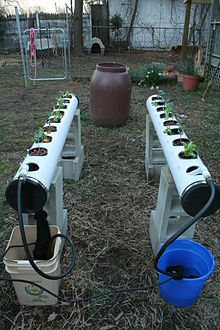
Here we will go through all the materials needed, and how you can construct an all-in-one NFT system.
Materials Required
- 8 x 8 ft. 2×4 pieces of lumber
- 3 x Sawhorse brackets
- 8 x 10 ft. X 3 in. PVC pipes
- 10 x 3 in. PVC elbows – long sweep
- 1 x 3 in. PVC elbow – short sweep
- 1 x 3 in. PVC pipe end cap
- 1 x 70-gallon reservoir – with cover (can be black or white. No light should enter)
- 6 ft. 1/4 in. Black Tubing
- 1 x Submersible water pump
- 1 x Submersible Pump filter bag
- 1 x air pump – optional for maximum nutrient aeration
- 18 x metal plant hangers (can use galvanized 3/4 inch hanger strap)
- 36 x screws for plant hangers/ hanger strap
- 1 large pack of 2 inch Net Pots
- 1 x electric drill
- 1 x 1/4 inch drill bit
- 1 x 1.5-inch self-feed or hole saw drill bit. Don’t cut a 2-inch hole or your net pots may fall in.
Assembly Instructions for an NFT System
While a lot can depend on your growing area, and how you can configure your NFT system. This system allows plants to grow around every part of the system if space allows. This means you will need access to both sides and both ends of the structure.
Making the Frame
- Connect the 2×4 lumber into the sawhorse brackets. This will give you 3 sets.
- Depending on where your growing area is, the feet can be buried for extra support
- Space the A-frames so one of the 2×4’s can sit across the top in the sawhorse bracket. Around 3.5 ft. in between the center A-frame and the outer ones are ideal.
- Brace the A-frames apart with some of the remaining 2×4 lumber.
- Make sure your three A-frames are sturdy before you add your tubing.
Preparing the PVC Tubing
- Before drilling holes and connecting the pipes, you need to cut the end pipes to length.
- At this point connect your plant hangers (Plant hangers are easier to use) to the legs on either side. When you measure, you need to allow for no more than a 2% gradient on each side of your planter frame.
- Place 6 of your 10 ft. tubes to the plant hangers and add the long sweep elbows. You can then cut the shorter lengths to connect these together. Mark on your pipes where the elbows fit.
- Your tubing should run around the A-frame from the top of one side to the bottom of the other (where your reservoir will sit).
- Once you have dry assembled your NFT system, you are ready to drill your holes.
- Allowing for where the elbows meet the long tubes. Mark and drill holes 6 inches apart. These should also be marked and drilled in the shorter end tubes. A system of this size should accommodate around 120 holes.
- In the end, cap, drill a quarter inch hole for the black tubing to insert
- When you have all your holes cut, re-assemble your piping, so all the holes face upward. Although there should be a good seal, they may leak so using some PVC cement, fasten all your tubes, elbows and the end cap together.
- Place the short sweep elbow pointing downward as the return back to the reservoir.
Preparing the NFT Reservoir
The reservoir should sit below the lowest point of the end pipe. When you connect the last elbow, this should pass through the lid of the tank, so the nutrients are not exposed to light, and the tank is also kept in the dark to prevent any algae build-up. You can use any remaining piece of the tube to feed this from the pipe into the tank.
When you do this, allow for some space as the falling solution will help create oxygen in the water.
As the system recirculates, you should place your submersible water pump inside the filter bag. This can reduce the chance of any debris clogging the pump. From the pump, you need to connect one end of your black tubing, this then goes up to the hole in the end cap and feeds inside.
For additional aeration, you can also make use of an air pump and air stones. This will help the uptake of oxygen by your plants.
At this point, you are ready to fill your tank and run water through the system.
Unlike other systems that have their pump controlled by a timer, this one runs 24/7, so there is always a supply of water and nutrients to the root systems.
NFT System Things to Consider
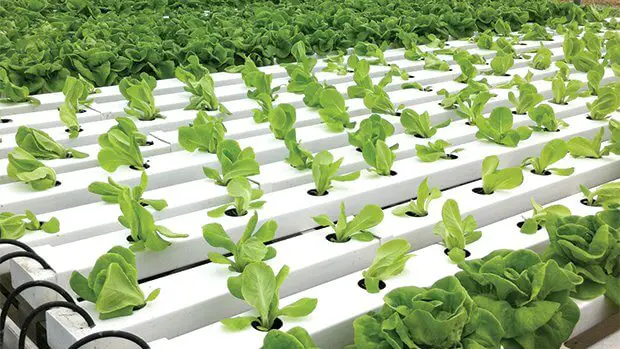
When you build this system, there are a couple of things to consider. These are just small things that can make your system operate more efficiently and help deliver the optimum conditions for your plants.
With this and many other systems, growers use round PVC, this is easier to find and to work with. In these systems, the solution can’t cover the root tips evenly. Flow rate and the slope of the tubes can lead to problems if they are not ideal.
If you can find flat-based gutters with a solid cover, this is ideal, or any square PVC tube. Systems that use this are more often made from square tubing which is purpose-built for this. While you may think there are problems with the elbows, you can still use round pipes, but you will lose the chance to grow plants at this point.
The tubes on the system above are 10 feet in length, which is the longest you should go before you can encounter problems. Once you run the system, the plants at the very beginning of the tube run will receive the most nutrients, and the plants closer to the reservoir will receive the least.
Longer tubing might appear a good idea, but it can become detrimental to plant growth. Keep an eye on all the plant’s growth to make sure they are growing evenly.
When transplanting your seedlings, you can use a small amount of growing medium to help support the growing plants. Most often, expanded clay pebbles are used as they are inert and won’t affect the pH levels of your solution. They are also very light and won’t place any excess weight on your tube supports.
If you decide to use an air pump with air stones, the larger the air stone, the better. This isn’t necessary, but the addition of these can help keep water agitated and will help your nutrient solution to last a little longer.
Like any hydroponic reservoir, you do need to make sure there is no light entering your tank, but one area many growers forget is the holes in their pipes. If there are no plants inside these holes, light can enter, and algae growth can occur. You can prevent this by covering the holes with a short PVC tube that has been split. This makes an ideal snap-over cover.
While the system above uses a 70-gallon tank, this doesn’t mean you can’t go larger. If you have the opportunity, a larger tank can help buffer your solution and to maintain temperature levels.
Prepare Seedlings for Transplanting to an NFT System
When you are preparing your seeds, these will more often be started in starter cubes. These cubes can be made from different materials such as Rockwool or Coco Coir which are the most commonly used. Anything that can break away like peat moss can run down the channel and lead to a buildup in the tank and cause your water pump to clog.
When you come to ready your cubes, you will soak these thoroughly, this saturates them as well as washing out any excess salts that may have accumulated.
Because of poor germination or wastage, you should allow for this and plant around an extra 10% more. At this part of the germination phase, you shouldn’t be using any nutrients. Once they begin showing root growth, you need to keep the cubes moist but not oversaturated.
Once the roots are protruding from the bottom of the cube, you can then transplant these into your net pots and your NFT channels. This will be around the ten days to 2-week period, although this will depend on your growing environment.
Choosing the Right NFT Water Pump
Out of all the areas which are crucial in an NFT system, it is that of your nutrient flow. With this, you do need to find the ideal-sized submersible water pump.
To do this, we need to know the maximum head height the pump can work too. This is the height at which your pump can deliver the solution. As an example, if a pump has a head height of six feet, it can pump comfortably to a height of six feet in a vertical direction. If your inlet pipe is higher than this, then your pump can’t sufficiently deliver water. The reason for this is the weight of the liquid is greater than the force from the pump.
To calculate the size of the pump required, you need to measure from the top of your reservoir to the highest point of your NFT system. Once you have this, you should add a further 20% as a buffer. With this, you will be sure your pump can comfortably deliver water to this height.
When looking for pumps, you need to remember, NFT systems don’t need high volumes of water. Because of this, you should choose a pump that is closest to your measurements without being under.
One other thing to remember is, GPH (Gallons per hour) and head height are not the same, but generally, as one increases, so does the other. What we need to look for is the lowest GPH pump, but one that meets the head height.
When you have this, you can think about moderating your flow, too much and you won’t be able to create the film inside the tubes.
This flow variation can be made if you have an inline tap where you can adjust the flow, but an easier way is to use a submersible water pump that comes with a variable flow rate. These are ideal for this kind of system as you can really fine-tune your flow to meet the needs of your system. They are also easy to adjust without the need for additional plumbing in your inlet tubes.
One final area where these pumps prove their worth is that as your plants grow, the flow of your solution may need to increase. You can find this by checking the last plants in the stream, if these begin showing signs of nutrient deficiency, then you merely increase the flow rate.
Conclusion
As long as you follow the essential elements of an NFT system, these are very easy to run and maintain. All the same considerations for cleaning and balancing pH levels are still there, but they can be more stable once it is running.
While the above system is of a specific design, you can very easily modify this to build a system that fits into your growing area. Many growers have this kind of system flat against a wall rather than spiraling around a frame. Others have these set out in rows that are all level, and the solution is pumped into each channel individually.
Designs are varied, and will only be dictated by the size of the grow room and if you are using grow lights.
Whatever design you use, you will very quickly find that these systems produce great results for the types of plants they are intended for. Building them takes little effort, and once seedlings are transplanted, you can look forward to the highest of yields.

